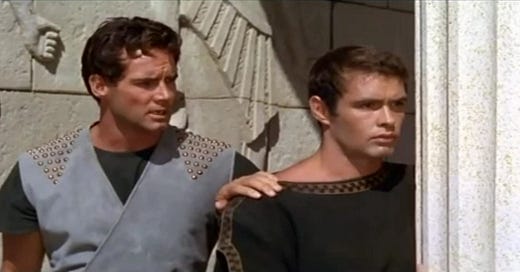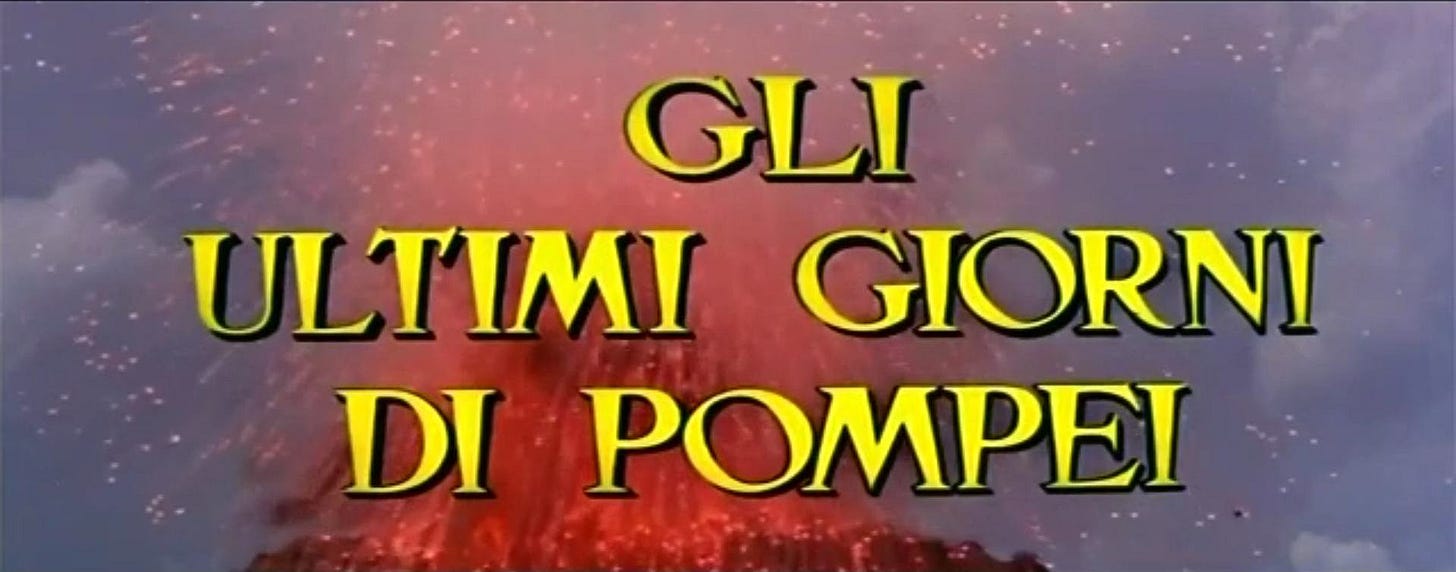PLOT
A band of thieves and murderers sign their crimes with a cross to place the blame on the Christians. When Glaucus returns from the war front and learns that his family was slaughtered by these Christians, he swears to avenge them.
REVIEW
Peplums can be fun, even when they’re bad. Fortunately, this one isn’t bad, even if it’s not perfect—then again, is there such a thing as a perfect movie?
Before we get started, I should say a few words about the origins of this film.
Executive producer Paolo Moffa had co-directed (with French director Marcel L’Herbier) a previous black-and-white version of Bulwer-Lytton’s novel in 1950. Wanting to explore the possibilities offered by the new Eastmancolor and Supertotalscope technologies, he thought this subject would be a perfect fit.
Though largely forgotten today, Mario Bonnard was at the time an experienced and respected Italian director. He had mostly made comedies, but also shot the epic “Slave women of Corinth” in 1958 (about the goddess Athena). So Moffa felt he was a natural choice. Sergio Leone, who had worked as a co-writer and second unit director on the Athena film, was hired in the same capacity on the Pompeii project.
On the second day of shooting, Bonnard fell ill and Leone naturally stepped in. So while the latter was not credited for it, he ended up shooting most of the film himself—making this technically (if not officially) his directorial debut. He would, of course, go on to greater fame for his spaghetti westerns of the 60s.
Now that that’s out of the way, let’s look at the script.
On the plus side, there are few issues in this film. Only two stood out to me—well, three if you count the point I’ll make at the end, but we’ll get to that in good time.
So there’s a scene (minor spoiler coming) during the festivities when Antonius suspects a drunkard of being one of the criminals who killed Glaucus’ family. He goes to report this to Glaucus’ friends. Marcus follows the drunkard to the temple of Isis... And here I’m like, wait, why is this guy going there? The plot needs it, sure, but it doesn’t make sense. If you’re drunk, how likely are you to just randomly go to the leader of the conspiracy you’re a part of—and to do what exactly? We don’t know, it’s not shown. Later in the film, the same man (now no longer drunk) goes back to the temple just so Antonius can follow him. This time we do see a conversation between him and the high priest, so there’s a greater purpose here, but it still feels weird because of the earlier scene.
The other thing that bothers me is when the fake Christians ambush Glaucus and leave him for dead. He falls into the river and its flow carries him downstream. At one point, he crawls out, stands, holds his wounded chest, then slumps to the floor as if unconscious.
Now, before I explain the problem here, I need to give more context. At this point, Glaucus has figured out who is really behind the attacks and needs to warn the consul. But Ascanius is out of town. So the tribune decides to ride at all speed to wherever Ascanius went (sorry but I didn’t quite catch where he went—either a nearby city or a remote villa he owns, something like that). Either way, it’s obvious the place is some distance away, as he is riding his horse hard to make good time.
With this in mind, the ambush happens shortly after he leaves Pompeii. The stream carries him a bit (though not too far), then he crawls out and falls unconscious. At this point, I was expecting some people to find him and heal him (possibly real Christians). Instead, in the next scene, we see Ascanius in his villa talking with Julia, and in comes stumbling our wounded hero.
What?
How the heck did he manage to go all this distance on foot (his horse was killed in the ambush) and with such a nasty wound?
If one can overlook these two issues, the film is pretty solid. The script holds up and, even if it’s not the most original plot in the world, it’s entertaining enough. The acting is fair, the settings and costumes are well-made and believable, and the special effects impressive.
Overall, it’s rather good.
Now, I can hear some of you wondering what any of this has to do with the famous volcano explosion that destroyed Pompeii? Excellent question. Thank you for asking.
This movie raises an interesting question. Should a film with a disaster in it focus on anything else but the disaster?
During the first half, I kept waiting for signs, expecting something tragic to happen with the Vesuvius. Then (to the film’s credit, I suppose) you get carried by the story and it sort of slips your mind.
Until the explosion comes... thirteen minutes before the end.
And this is my main beef with this film. There is no foreshadowing whatsoever. No steaming grass, no tremors, no fleeing animals, no cracking earth, no dead plants... Heck, we don’t even see the volcano until that final scene.
To add insult to injury, there is no lava. At all. What we are given is more of an earthquake—albeit a massive one—than a volcano eruption.
Don’t get me wrong, those ten minutes are intense and extremely well done, but it felt... rushed?
Here’s the thing. When you get dragged into a plot that feels interesting enough, you want resolution—some sort of closure. But the volcano erupts JUST when we are about to get that closure. It makes it feel like either the eruption was the whole point and everything else was filler material, or the plot was the focus and they added the volcano (and chose the film title accordingly) as an afterthought.
Mind you, this was made a decade before disaster movies became a major trend, at a time when peplums were popular, so it makes sense that the peplum aspect was the focus.
I wrote an article last week about Irwin Allen—the man behind “The Poseidon adventure” and “The towering inferno”—and I can’t help but wonder what he would have done with a film about Pompeii. It would have been quite different, that’s for sure.
Still, the film does give us some closure in the final three minutes, and the bad guys do get what they had coming... I just wish it’d have been done differently.
This felt a bit frustrating.
—
Have you watched this film? What did you think of it?
What is your favorite peplum?
Let us know in the comments!
TRIVIA NOTES
Steve Reeves was an American bodybuilder who became a peplum star in the late 50s and 60s. He shot to fame when he was cast as Hercules in the Italian films “Hercules” and “Hercules unchained.” He hurt his shoulder while filming “The last days of Pompeii” and the wound grew more painful over the years, eventually forcing him to retire early.
Ennio de Concini was a prolific Italian screenwriter with over one hundred films to his credit. Some of his most famous scripts include “Ulysses” (1954, with Kirk Douglas), “Attila” (1954, with Anthony Quinn), “War and peace” (1956), “Hercules” (1958, with Steve Reeves), “Esther and the King” (1960), “Divorce Italian style” (1961), “The Colossus of Rhodes” (1961, directed by Sergio Leone), “Battle of the worlds” (1961), and “Marco Polo” (1962, with Rory Calhoun).
While Sergio Leone did not invent spaghetti westerns, “A fistful of dollars” was the first to gain such widespread and international success—both commercial and critical—and thus launched a plethora of imitators. The director’s following movies were all hugely popular: “For a few dollars more,” “The good, the bad, and the ugly,” “Once upon a time in the West,” “Duck you sucker,” and “Once upon a time in America.”
Duccio Tessari was instrumental in the popularity of spaghetti westerns both as a writer (Leone’s “A fistful of dollars”) and later as a director (the “Ringo” films starring Giuliano Gemma). He was also a writer on Henry Levin’s “The wonders of Aladdin.”
As a director, Sergio Corbucci shot both gentle comedies and violent westerns. His credits include “Django” (starring Franco Nero in the title role), “The mercenary,” “The great silence,” “Navajo Joe” (with Burt Reynolds), and “The white, the yellow, and the black.” His younger brother was writer-director Bruno Corbucci.
The high priest of Isis is played by Fernando Rey, a Spanish actor with an international career. He often appeared in Luis Buñuel’s films (including “The obscure object of desire”) and had notable parts in “Return of the seven,” “Navajo Joe,” Orson Welles’ “The immortal story,” “The French Connection,” “White Fang,” “Voyage of the damned,” “Caboblanco,” and Ridley Scott’s “1492: Conquest of Paradise.”
Guillermo Marin was another Spanish actor. He was a leading man in the 1940s but focused his career on stage work in later years.
Credited as the second unit cinematographer, Enzo Barboni later gained fame as a director. Under the name of E.B. Clucher, he directed “They call me Trinity” and its sequel “Trinity is still my name.” Both were hugely successful and skyrocketed the careers of Terence Hill and Bud Spencer. They also launched a new subgenre of comedic spaghetti westerns.
After starting as an actor in the silent era, Mario Bonnard turned to directing in 1916. He made comedies, period dramas, and epics. Though forgotten today, many of his films were quite successful at the time.
Executive producer Paolo Moffa began in the 30s as an assistant director before turning to production work in the 50s. He also directed seven films, including the 1950 version of “The last days of Pompeii.”
CREDITS
Directed by Mario Bonnard.
Screenplay by Ennio de Concini, Luigi Emmanuele, Sergio Leone, Duccio Tessari & Sergio Corbucci, based on the book by Edward Bulwer-Lytton.
Produced by Cesare Seccia & Eduardo de Lafuente.
Music by Angelo Francesco Lavagnino.
Cinematography by Antonio Ballesteros.
Edited by Eraldo Da Roma.
Starring Steve Reeves as Glaucus Leto, Christine Kaufmann as Ione, Fernando Rey as Arbaces, Barbara Carroll as Nydia, Annemarie Baumann as Julia, Mimmo Palmara as Gallinus, Guillermo Marin as Ascanius, Angel Aranda as Antonius, Carlo Tamberlani as Olinto the Christian leader, Mario Morales as Marcus, Mino Doro as second consul, Angel Ortiz as Helios, Mario Berriatua as Praetorian guard, Lola Torres as hotel keeper, Ignazio Dolce as Caius.
Produced by Cineproduzioni Associate (Italy) / Procusa (Spain) / Transocean (Monaco) / Film Vasgen Badal & Co. KG (Germany) / ABC Filmverleih (Germany).
Distributed by Filmar (Italy) / United Artists (USA).
Released on November 12, 1959 (Italy) / July 17, 1960 (USA).
Running time: 93 minutes.
Genre: Peplum.
Original title: Gli ultimi giorni di Pompei.
Italian poster by Luigi Martinati.
US poster by Ernest Chiriacka.
—
Share your thoughts in the comments! I would love to hear them.
If you enjoyed this review, please feel free to forward it to your friends or to share it on social media.
And don’t forget to like by clicking the little heart below this post ;)
—
Text (c) 2024 by Alex S. Garcia.
Header image: screenshot of the film’s original Italian title card.
Film posters from Pinterest (Italian poster) and IMDb (American poster).





